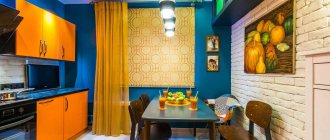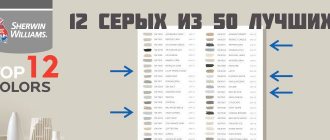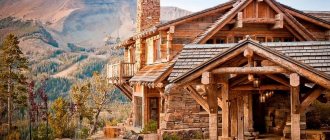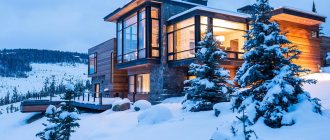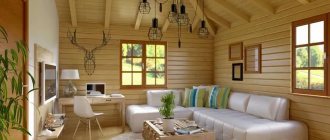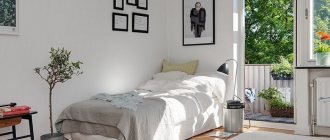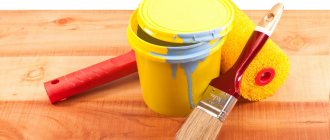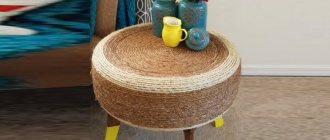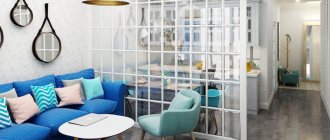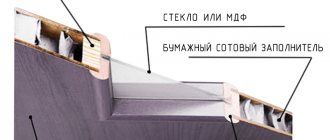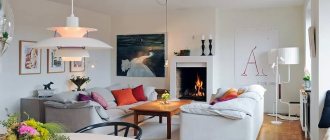Despite the modern abundance of various building materials, wooden houses remain traditional in almost all regions of Russia. From time immemorial, their log houses were erected in both urban and rural areas. Nowadays, the possibilities of using wood have expanded significantly - today, processed timber is widely used for the construction of residential buildings, frame structures made of lumber and plywood or chipboard (OSB) are used.
Painting a wooden house inside
Every home owner, when choosing natural wood or materials based on it to build a house, wants it to retain its original qualities for as long as possible. Therefore, painting a wooden house inside, as well as outside, is a mandatory process to create conditions for long-term operation of such buildings. In addition, this significantly expands the horizons in the possibilities of both external and interior design.
Why do you need to paint the inside of your house?
A wooden house is warm in winter and not hot in summer, because wood can breathe, creating a healthy microclimate in the house. But, if there is high humidity in the room, then mold, mildew, and pathogenic microorganisms can form in the wood, causing the wood to rot.
Wood is negatively affected by temperature changes, which can cause it to deform or crack. Sometimes in a log house you can see passages, small holes - this is wood eaten away by beetles. To prevent the house from being destroyed from the inside, protective solutions are used that will not only renew the appearance of the tree, but also protect it from destruction. And the best way to do this is paint.
Aging effect
You can make the interior of a room attractive and original by artificially aging finishing materials. Natural lining without coating looks monotonous. You can add antique value to it in several ways:
- Brushing. Suitable for pine or oak. The top layer of the rock is removed with a coarse brush, sanded and covered with stain of any color, for example, wenge;
- Pantination. Use two colors of paint, slightly different shades. The first enamel is applied in a thick layer and allowed to dry. Then paint a thin layer of lighter paint. After complete drying, rub the surface with sandpaper. The illusion of numerous repainting of the lining is created;
- Paraffin treatment. Wax is applied unevenly to individual areas. Then the pantining process is repeated. After drying, remove it with a spatula and treat the board with stain. The result is a worn effect.
Materials for surface preparation and coloring of wood for interior decoration
In order for the paint for the interior decoration of a wooden house to lay down evenly, you need to properly prepare the surface. To prepare for painting, antiseptics, fire retardants, bio-moisture protective solutions, primers, and bleaching agents are used.
Antiseptics and fire retardants for preparing wood for painting
Antiseptic solutions are needed to protect wood from the appearance of fungus and mold on its surface and inside, and to destroy harmful microorganisms.
Antiseptics include coatings and impregnations. Impregnations penetrate deep into the wood fibers. But, before use, you need to check the composition, as they can be toxic and should not be used indoors.
Coating materials are applied to the surface of wooden walls to protect against water. Such substances are intended for interior decoration of rooms with high humidity.
Antiseptic compositions are also divided into:
- water soluble. These are environmentally friendly, harmless products. But over time, their protective properties decrease. They are used before painting surfaces with water-dispersion paints;
- organic. Their protective indicators are high. But they are toxic, have a strong odor and are a fire hazard when dry. Therefore, they are not used for interior work, but only for painting facades;
- oil antiseptics - used for outdoor work due to their persistent odor and long drying time;
- combined antiseptic solutions are effective not only for external, but also for internal work. High-carbon and oil components of the composition provide high-quality protection against mold and rot. They are easily used in rooms with high humidity.
Each composition has its own brush with natural or artificial bristles.
The most popular are bio-moisture-protective antiseptics. They create a protective barrier from harmful influences, do not wash out, and give the wood an aesthetic appearance.
Fire retardants are products that protect wood from rapid fire. In the event of a fire, the walls of the house will not catch fire, but will begin to slowly smolder.
Fire retardants come in two types. Some contain salts that, when exposed to high temperatures, release gases that prevent combustion. The second type of fire retardants creates a protective coating on the surface in the form of foam.
Compositions that combine the qualities of antiseptics and fire retardants are called biopyrenes.
Primer solutions promote better adhesion of paint to the surface.
Varnishes as a protective and decorative agent
They are needed to renew the wooden covering and to protect it from harmful influences.
Varnishes are divided into:
- acrylic. They are environmentally friendly, non-toxic, have no pungent odors, but wear out quickly. Used to cover interior walls and furniture;
- polyurethane. They are water-based, so they do not emit harmful substances, and they have almost no odor. Such varnishes have high strength properties and do not wear out for a long time. Used to cover walls and floors indoors;
- alcohol They are made of natural resins, have high strength, but allow moisture to pass through, so it is not recommended to use them in a bathhouse or bathroom;
- nitrocellulose - consist of synthetic resins, solvents and cellulose nitrate. Some nitro varnishes are used only to prepare surfaces before painting. Other nitrocellulose varnishes are needed to create a durable finish. They are transparent, only highlighting the special grain of the wood. But these products are flammable in their uncured form and smell unpleasant;
- oil varnishes - form a durable protective glossy layer of a warm ocher shade on the surface. Used for finishing walls and furniture;
- alkyd - similar to oil ones, but have more durable performance characteristics. Used for finishing inside and outside.
Paints for finishing wooden walls
Dark coloring of a room visually reduces its size.
Paints for interior work should not be toxic, have a pungent odor, or harm human health. To find out how to paint timber inside a house and whether the characteristics of the products meet the main safety requirement, you need to familiarize yourself with its components. You can look at the coloring composition on the packaging or ask your sales consultant about it.
Material calculation
Before purchasing paints and varnishes, you need to calculate the required amount of product. For ease of understanding, an example of a calculation is given based on varnishing prepared parquet.
For a room with a floor area of 15 square meters, therefore, you will need
- water-based varnish 15 x (100…120) = 1500…1800 g or
- alkyd varnish 15 x 80 = 1200 g.
Calculations will be greatly simplified using special calculators.
The amount of primer, stain, impregnation and other things is calculated in the same way. When making calculations, it is important to reserve at least 10% for unforeseen circumstances or possible problems with some of the materials.
Choosing paint based on purpose
There are several types of paint for interior work. They differ in composition, drying time and price.
The colors are:
- water based. They are not resistant to moisture and are easily washed off with water;
- organic. They are based on a solvent. Such paints are moisture resistant, have a high level of hiding power, and have a long service life. But they are not always used for interior painting, because they contain solvents and other fast-drying substances. They have a strong odor, are flammable and emit toxic components that are harmful to the health of people and pets.
Acrylic
Acrylic paints reliably protect walls from harmful influences and are durable. Provide high adhesion to surfaces, prevent cracking and deformation during shrinkage.
Alkyd and enamels
These paints give a glossy surface effect. They dry quickly due to the solvent they contain, but they smell unpleasant.
It is better to work with them in a respirator, because among different alkyd enamels there are products that release toxic substances.
The surface painted with enamel is durable, can be easily washed, and is not afraid of aggressive detergents. But, over time, the enamel turns yellow and fades from direct sunlight.
Water-dispersed
Water-based paints contain a lot of water, so it is not recommended to paint glossy and metal objects with them. Water-based paint is considered an environmentally friendly and safe paint because it does not emit toxic substances. It consists of an aqueous suspension, polymers and fillers. Due to polymers, the water base evaporates during application, leaving a thin film on the surface. When painting with a brush or roller, no streaks remain.
Water-dispersion paints can be used to mask any darkened stain. They dry quickly and can be diluted with water to give the walls the desired shade. The protective layer of water-dispersion paints is less durable than that of varnishes and has low wear resistance.
Silicone
Silicone paints are a reliable coating. They are not prone to abrasion, do not allow moisture to pass through, and do not fade from exposure to ultraviolet rays.
The paint is made on the basis of silicone resins, and high vapor permeability preserves the wood’s ability to breathe. The product is elastic, so it can easily veil cracks up to 2mm thick. Long service life.
Oily
Oil paints are an organic type, created on the basis of drying oil. Since they take a long time to dry and have a sharp, unpleasant odor, they are rarely used for interior decoration and only in the warm season.
To dilute oil paints, use gasoline and white spirit. The paints apply easily, creating a durable opaque layer, but it is opaque, and the wood pattern is not visible through it. The shiny shade gives the surface painted with this product an excellent appearance and smoothes out any unevenness and defects in the wall surface. They can be wiped with a damp cloth and cleaned with detergents. The color of the painted surface will not change, will not fade, or be damaged.
Due to the fact that the paint composition releases harmful substances during the work process, when drying, it is used mainly for outdoor work. But important qualities: high strength and moisture resistance allow you to paint rooms inside the house with it. For example, for the bathroom and kitchen - rooms with high humidity.
Useful recommendations for purchasing paint and painting
When choosing and purchasing paint for the interior decoration of wooden walls, it is very important to pay attention to the date of manufacture of the composition and the availability of certificates confirming its quality and sanitary compliance. If the seller cannot provide documents for the product, and the production date is not stamped on the packaging, but is written on paper and pasted on top, so to speak, interrupted, then it is recommended to immediately refuse to purchase such paint, especially if a fairly expensive version is purchased.
The fact is that if the paint is expired or frozen, then it may simply not lie on the surface, even if it is well prepared, and you can determine the quality of the composition only by opening the package and trying to apply it to the wood. For example, it will not be possible to paint anything with a frozen solution, since the paint will most likely curdle and have the consistency of liquid cottage cheese.
High-quality paint should spread easily over the surface of the wood, while having high hiding power
If the paint is of high quality, it will be easily applied to the surface, which means that painting the walls can be done by a person who has never even performed such repair work before.
Next, it is worth considering those factors that will directly affect the final finishing result.
- First thing to note. It is a common phenomenon that many homeowners, when doing their own renovations in a house or apartment, are careless about the preparatory stage of work, since they consider it unnecessary. However, if the base for the decorative coating is uneven and untreated with protective agents, you should not expect the desired result. In addition, after a short time, even defects that are invisible immediately after completion of the work will begin to appear, for example, such as blue discoloration, blackness of the wood, or “resin pockets” near knots. Therefore, the preparatory process must be considered mandatory and carried out as efficiently as possible.
- When treating wood with one of the protective compounds, it is necessary to very carefully process the end parts of logs or beams if they face the rooms. If the walls of the house are covered with clapboard, then its side surfaces should also be carefully treated with antiseptic solutions.
- All protective and coloring compounds are applied to wooden surfaces in thin layers along the grain, otherwise their absorption into the wood will be uneven, which will negatively affect the overall appearance.
This simple “improvement” from ordinary rubber rings will greatly simplify the process of applying paint with a brush from a can.
- To ensure that there is no excess paint on the brush, and that it does not flow, but lies flat, it is recommended to use a simple device consisting of two stationery or ordinary rubber bands. One of the rubber bands is put on the bottom and top of the can, and the second along its diameter. The second elastic band will hold the first one, preventing it from sliding to the side.
After dipping the brush into the paint, press it against the stretched rubber band, leaving excess solution in the container.
- When applying paint to the surface of wood, do not try to cover it with a thick layer at once, as the painting will turn out sloppy. If you plan to get an opaque surface, then you should apply the paint in several thin layers, each of which should be applied after the previous one has completely dried.
- When painting walls covered with wooden clapboards, it is best to apply the final top coat starting at the top and gradually moving down - this method will help make the surface of the wall smooth.
- Paint can look different in a can and on the wall, so it is recommended to do a test paint job, that is, apply the solution to a small section of the wall in an inconspicuous area. It is best to choose the lower corner part of the surface.
- In order for the decorative layer to lie evenly on the surface, experts recommend adding a color to the primer that is one or two tones darker or lighter than the base color.
- The optimal temperature for painting surfaces is 22÷25 degrees. You should not carry out this process in hot weather, as the paint will dry too quickly and therefore unevenly. If the temperature is too low, the fluidity and hiding power of the compositions deteriorate, and the drying period increases.
Color selection, recommendations
To choose the right paint color, you need to take into account the style of the interior - the color of the walls should be combined with the design and style of the room. If you want to decorate the inside of your house in a classic style, then painting should be done with transparent compounds to highlight the beauty and grain of the wood. The Scandinavian style is characterized by pastel and white colors. If you need to visually expand the space, then you should choose light-colored paint, and if you need to narrow it, then dark ones.
Pastel colors look harmonious in the interior of a house made of rounded logs and are combined with modern appliances
How to paint lining like bleached oak
You can achieve the effect of bleached oak and preserve the natural beauty of the tree using frost stain, white oak stain, transparent wax oil, polyurethane, or bleached acrylic pigment.
First of all, apply the tint in a thin layer. Then cover with oil. The thickness of application depends on the expected result. If you need a clearly defined pattern, remove the excess and wipe the surface with a rag. You can whiten wood using a primer. But it is worth considering that on some breeds it will turn yellow over time. For example, pine material can be whitened with regular gray wood paint.
Required tools and supplies
In order to paint wooden walls from the inside of the house, use the following materials and tools:
- masking tape. It is necessary to protect the surfaces bordering the walls from staining;
- film to cover the floor, doors and furniture;
- sander for preparing walls;
- construction hair dryer and scraper for cleaning old paint;
- brushes, rollers and paint trays;
- sprayer for automatic application of the product;
- protective clothing: rubber gloves, safety glasses, respirator;
- a bucket of water, a rag for wiping away spills.
Preparatory work
Before painting, remove the old coating and sand the boards.
Painting the inside of a house begins with preparing the surfaces. A wooden wall, by its nature, remains porous. In order for the paint to lay evenly on it, the following is required:
- The walls are cleaned of dust and dirt.
- Remove the old finishing layer, if any. The paint is washed off or removed using a sanding machine.
- They inspect the walls. If mold or rotten spots are found on the wood, these places are cleaned with a wire brush. Then the areas are treated with antiseptic impregnations or primers to protect the wood from fungi and mold. Boards that are more than half rotten are replaced with new ones.
- Nail heads and remnants of other fasteners are removed.
- Fallen knots, cracks, and gaps are filled with plaster mixtures with sawdust. After drying, the areas are smoothed with sandpaper.
- Before painting wooden walls inside and outside the house, the surface is impregnated with a primer. This composition improves the degree of adhesion of paint to wood.
Other measures may be necessary, for example, leveling or sanding walls, additional treatment with antiseptics or bleaches.
Step-by-step instructions for painting a wooden wall indoors
One has only to deviate from the work technology, and the painted surface will spoil the aesthetic appearance of the finish. Let's look at how the interior painting of a wooden house goes: kitchen, children's room, bathroom, living room.
Preparing the surface for painting
Before painting, you need to properly prepare the room:
- First of all, you need to remove the old paint coating. To do this, it is heated with a hair dryer and cleaned off with a scraper or spatula.
- If the inside of the log house has not been painted, but the building material has rotted or darkened, then it is important to remove the damaged wood using a sander.
- You can use an electric plane to deep clean wood. New wood is also sanded smooth.
- Then the wooden walls are coated with antiseptics and fire retardants using a brush or roller. In a log house it is better to use a spray bottle.
Preparing walls for painting is done using petal wheels made of sandpaper with a grain size of 100 -120
Leveling the surface
Before painting, it is important to make the surface smooth, remove defects and knots, so the surface is treated with a grinder. Fine sandpaper will also help smooth out uneven surfaces.
Painting technology
For painting you can use a brush and roller. The roller allows you to cover large areas of the wall and evenly distribute the paint composition over it. Use a brush to go over the joints between logs and corner joints. The paint should be applied in 2-3 layers after the previous one has completely dried.
Why does the lining need to be painted?
In the opinion of many, the lining should not be treated with any additional materials. There is some truth in this statement, however, such an individual material as wood does not tolerate all microclimate changes well.
And it doesn’t suit every interior. For example, with poor ventilation, wood gradually begins to deteriorate, and with prolonged contact with direct sunlight, it completely loses color, turns gray or fades.
- When the lining begins to turn blue, the change in color can only be hidden using certain biological means. Oxygen or chlorine will help you.
- After treatment with them, the wooden surface must be additionally coated with protective agents, if desired, with paints and varnishes.
- After contact with the sun, traces of burnout can be hidden through mechanical intervention.
- Remove the top layer, sanding the affected areas well. In any case, the solution - painting the lining - will help you avoid all these problems.
It is worth noting that not everyone likes the appearance of wood. It does not always harmonize with the main interior of the room.
And the view starts to get boring over time. Therefore, the best option is to make minor cosmetic repairs by repainting the walls with opaque paint.
Mistakes when painting yourself
If you decide to paint the walls inside a wooden house with your own hands, then do not make mistakes that can lead to disastrous results:
- lack of preparatory work. Before painting the inside of a log house, it is important to seal all the cracks and level the surfaces. Only on a smooth wall will the paint lie smoothly. In addition, the primer will increase the adhesion of the paint to the wood;
- violation of paint mixing technology. The composition must be diluted exactly according to the instructions recommended by the manufacturer;
- use of low-grade materials. If the paint is inexpensive and of poor quality, then after a while it will peel off, and you will have to renew the coating and spend extra money.
We conclude: in order to paint the walls of a wooden house from the inside efficiently and beautifully, you need to carefully prepare the surface and use good paint.
Painting wood while maintaining texture
Painting the lining and maintaining the wood texture is very simple. For this purpose, varnish, pigmented oils and glazes are used. Work can be carried out on separate boards or already on a sheathed wall. Use a roller and several brushes of different sizes.
Texturing technology involves applying dispersion varnish with a brush to small fragments of material and then evenly distributing it. Use a roller for spreading. It is necessary to move strictly along natural furrows. After 10 minutes, remove excess mixture. The varnish remains in the grooves, making the design bright and shiny.
Coloring ideas
Painting lining inside a house has many variations: photos of interiors will show the variety of existing ideas. One of the new decorations was the combination of smooth walls and wooden paneling.
The combination of boards of different thicknesses looks unusual. Thin panels are inserted between wide ones, and then the boards are painted the same color, but of different intensities.
Smooth boards and eurolining are used to form waves or depressions on the wall. To emphasize lighting areas on the walls, you can play with color: paint the trim near the lamps with light paint to highlight this area.
The lining on massive ceilings is whitened, and the beams are covered with dark paint. The room looks modern, despite the usual cladding materials.
Wooden cladding also has a place in showers and baths. It is important to ensure high-quality ventilation of the room and treat the boards with moisture-resistant impregnation. Warm wood tones around the perimeter and bright tiles on the floor will give the bathroom a dramatic look.
For a child’s bedroom, you can paint on the lining. After drying, the resulting painting is coated with varnish/oil without color.
Painted lining in the interior when decorating rooms is suitable for admirers of natural materials in the interior. A large selection of panel painting methods will allow you to create an exclusive wall covering that will protect the lining from damage and extend its service life.
Wooden house interior styles
English style
Wood looks good in English interiors, which are characterized by restraint, severity and luxury.
With the help of this retro style, they try to emphasize the excellent taste and status of the owners, so a lot of money is required to create it.
Wooden interiors in the English style allow you to hide massive walls with wallpaper or plasterboard. The walls are decorated with floral designs, stripes and other patterns.
Spacious soft sofas with floral patterns and a carpet with an original pattern, but in restrained colors, are welcome here.
Solid furniture is combined with many details, exquisite paintings and porcelain.
The ceiling is decorated with beams or stucco. The English living room plays the role of a reception hall, so it is richly decorated: a stone or brick fireplace, weapons, portraits, oak panels.
Hunting house (chalet)
Many people associate a wooden house with a hunting lodge. The interiors of the wooden houses are decorated with trophies, large leather sofas and stuffed animals.
There should be a fireplace inside the chalet buildings, preferably a real one. Carpets are not just laid on the floor. However, instead of carpets, animal skins are often found.
The walls are decorated with large tapestries, landscapes and animal horns. Don't forget about guns and other hunting equipment.
The floors in hunting lodges are often artificially aged. Solid boards that are not coated with paint or varnish are a good choice.
Only semi-matte or matte slabs are allowed. The floors in the kitchens and bathrooms are tiled with natural stone. To create an antique effect, you can use tiles that imitate chips and cracks.
The ceiling in the cottage is decorated with massive beams. The ceilings themselves are also made of wood.
Scandinavian style
Scandinavian style is characterized by the minimalism of objects and the functionality of each item. It is dominated by white tones, light furniture and impeccable elegance of lines.
Russian style
“A rustic cottage in the Russian style is characterized by the solidity and simplicity of its elements.
Here the main elements will be typical benches and antique chests, display cases and chests of drawers, carved beds with embroidered pillows. The Russian stove will give this style a special charm.
Japanese style
All elements of traditional Japanese style will find their place in a cozy wooden cottage. The floor is covered with bamboo mats, which can be found in any national home if you happen to visit Japan. Walls are often replaced with simple paper partitions. Furniture in this style is quite modest and should be thought through from the very beginning. Japanese style is characterized by calm, comfort, coziness and, above all, naturalness. Therefore, avoid the abundance of modern materials such as glass, plastic, metal and synthetic fabrics. It is better not to use them at all or add them to the interior in very small quantities.
Interior design of a private country house in Japanese style
An alternative to typical Japanese-style tables, low bamboo tables are easy to move and rearrange even for a girl. Chairs are replaced by pouffes, pillows, soft stands and traditional tatami. It is exotic and spectacular, so you will have something to surprise your guests.
Japanese style also includes a small fireplace, which adds a cozy and relaxed feeling.
The bedroom should have tatami beds and low tatami bedside tables. The interior of a wooden house in the Japanese style is best done in light colors. In Japan, this is done using the national plant - bamboo. In our regions, its substitute will be the following types of wood: pine, spruce, larch.
The interiors of Japanese-style wooden houses are best done in light colors. Tapestries depicting Japanese philosophers and sages hang on the walls.
The decoration will be candlesticks made of rice paper and hieroglyphs and other decorative items painted on the walls.
The bedroom should have tatami beds and low tatami bedside tables.
Mediterranean style
This style originated in Italy. Its more typical name is “Tuscan”. Italians use this style to decorate their brick houses in the southern regions. But it is also ideal for decorating wooden houses, and our designers have created thousands of "Tuscan" designs.
Interior design for a private Mediterranean house in a rustic style
The Mediterranean-style ceiling features exposed beams, and the kitchen countertops and floor are tiled. Choosing colorful tiles is a great idea as it will create a traditional Italian cottage feel. Colors include peach, warm green, orange and ochre.
The Mediterranean style originated in Italy.
The housekeeper's apron should preferably be traditional or embroidered.
The floor should be made of solid wood with a uniform color and texture. Linoleum is an inexpensive flooring option. If you choose not the cheapest option, but good quality, it will look very natural and natural and will fit perfectly into the Tuscan interior.
Mediterranean style flooring is made from solid wood.
Luxurious pendant lamps with deliberately low shades are used for lighting. Ideally, they should look old-fashioned, as if they are hundreds of years old. But the devices can be very simple: built into the ceiling or mounted on the wall.
Remember that fresh flowers are the main element of Italian style. You can buy several seedlings or place pots on the windowsill.
Bed and chair covers should be simple, light and warm, with cheerful floral or plant motifs. The windows should have beautiful curtains with frills and ruffles at the bottom. The surface of one of the walls can be artificially aged for several decades: against such a background, rich furniture will look very impressive.
Bedspreads and chairs should be simple.
country style
Country" means country in English. This is a simple but very cozy style that will give your home a warm and homely atmosphere. Country style is characterized by light and bright fabrics that harmonize perfectly with the color of the wood. When using this style in the interior, your home will be as close as possible to the so-called “grandmother’s house in the village.”
Old, worn things should be everywhere, but don’t replace all the furniture with them. Antiques are just accents, don’t get carried away with the aged effect. Of course, the most important thing is the furniture that maintains the country atmosphere. It should contain simple lines and a minimum of decorative details. Country style is characterized by limited functionality, unpolished furniture and a light, rustic atmosphere. Long rustic benches, simple straight chairs, shelves, kitchen cabinets and simple beds without fancy bedding are a nice touch.
Interior design of a country house in a rustic style
An excellent solution to bring a touch of country into your home would be to install forged and wicker furniture. Cabinets can be replaced with antique drawers that you may have salvaged from a barn or attic of an old house.
There are many different ways to decorate a country house
Replacing all your dishes with porcelain or even wood is a good idea.
Curtains should be made from simple, natural materials. They can be cotton, linen or chintz. They may have a small design, such as dots or a flower. Such curtains are one of the hallmarks of traditional country style. Their main task is not to decorate the house, but to perform their function.
Country style is characterized by light and bright shades of fabrics.
It is recommended to use lamps with lampshades, tablecloths, bedspreads and napkins with hand embroidery. On the walls you can place paintings depicting rural landscapes. All country houses have a real or simulated fireplace. Check out photos of DIY farmhouse interior design.
Country style curtains should be made from simple, natural materials
German style
The first thing that comes to mind when talking about German style is half-timbered houses.
The half-timbered house, or German house, is the basis of the German style. The main elements of a house are beams (wooden logs), strut (vertical wood support) and braces (wooden beams placed at an angle). Thus, the structure does not contain central load-bearing elements. The space between the wooden beams is filled with site-specific materials such as clay, stone or bricks.
German country style:
- The key elements of a half-timbered house are wooden beams. They are present not only on the outside of the house, but also on the inside.
- Asceticism, practicality and functionality are qualities that can be seen in all of them. German interiors do not need to surprise with unexpected solutions. They are designed for comfortable living in this space.
Bathroom in a German house
- Wall decoration corresponding to the purpose of the room. Tiles are used in the kitchen and hallway, and the walls in the bedroom and living room are wallpapered or painted. The simplicity of the decoration is in harmony with the large windows with wooden frames. Windows are usually rectangular or arched and divided into sections. Typical of German half-timbered houses are shutters, but the windows are not covered with heavy curtains. Curtains, if any, should be light and translucent.
The style of decorating a living room in a German country house is spacious and full of light.
- The color scheme is restrained and strict, the tones are soft and warm. The colors commonly used are beige, brown, milky, sand and terracotta. Less common colors are green, olive, light pink, blue and gray. Furniture in these shades contrasts favorably with dark wooden floors.
- The fireplace is a key element of almost every rustic style, and in this case it is also important. Most often, the fireplace is located in the living room, surrounded by a massive sofa and soft armchairs. Paintings, old family photographs and hunting trophies hang on the walls. There should be a fine-pile carpet on the floor.
- The more light in the house, the better. For German style, choose large vintage chandeliers made of dark metal.
- Simple furniture that performs a specific function. However, the products must be made from high quality natural materials, mainly wood, wrought iron and leather.
Modern house in rustic style
- The interior of a kitchen is in a rustic style, which should amaze not with its decor, but with its functionality (like any room in the German style). Furniture made from modern high-quality materials and good household appliances fit into this picture. German kitchen decor - beautiful curtains, beautiful dishes and fresh flowers.
- There is no pretentiousness in the decor, no sculptures, stucco moldings or anything else. Stylized tableware, candlesticks and food baskets may be present, but these are items commonly used in everyday life. Thus, even the decor fulfills its practical function.
Simple, rustic design
Finnish style
The country of endless forests has left an indelible mark on the interiors of houses. There is a lot of air, light and space. Snow-white ceilings with stucco, a fireplace in the living room and huge windows with light translucent curtains. The space is zoned with simple wooden furniture. Cozy blankets and knitted pillows are a must. The color scheme is modest. Milky white, blue, shades of terracotta and ocher. Finnish style for those who value comfort and practicality.
Designer Maria Ivanova
